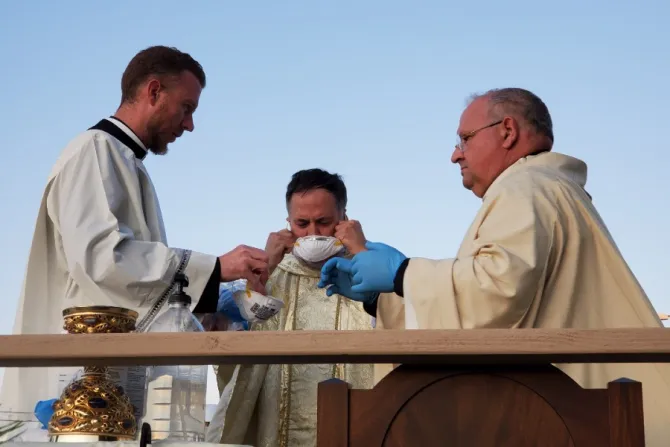CNA Staff, Apr 30, 2020 / 15:00 pm
As more Catholic dioceses begin to resume public Masses during the coronavirus pandemic, a group of theologians and medical experts has provided guidance for doing so as safely as possible.
"With proper safeguards to prevent infection, and integrating the scientific guidance of public health authorities as outlined below, it is possible to provide the Mass and the sacraments to the faithful in this period," said a group of Domican theologians and experts on infectious diseases this week.
The Working Group on Infectious Disease Protocols for Sacraments & Pastoral Care, a project of the Thomistic Institute, issued a document this week that aims to give guidance on "how Catholic sacraments can be provided in the midst of the current pandemic" under U.S. and global health standards.
The April 28 document from the Thomistic Institute outlines a multi-phase proposal for resumption and expansion of public Masses while remaining in conformity with public health guidelines in force in different places.
In "Phase 1," the "Sunday obligation" to attend Mass should be dispensed, the elderly and those at high risk of COVID-19 should be encouraged to stay home, and those with symptoms should not attend Mass, the working group said.
Other safeguards should be in place, such as requirements for attendees to wear face masks or cloth coverings and an overall limit on the number of attendees. This number depends "on the guidance of public health authorities," the document says, and could be more than 10 people provided that a church is large enough to seat everyone with at least six feet of distance in between.
Seating should be provided by ushers in designated areas so that all attendees can be seated in an orderly manner and remain spaced apart; after the end of Mass, they could be dismissed row by row so as not to result in a crowd leaving the church all at once, the working group said.
Priests should not offer Mass while wearing gloves and a facemask, especially if they are spaced far enough apart from ministers and attendees.
"A further consideration: the Mass is imbued with powerful sacramental and liturgical symbolism. Wearing a mask and gloves would be a detrimental counter-sign in this context, and it is not warranted by considerations of hygiene if the priest remains a proper distance from the congregation," the group states.
Mass could be offered without distribution of Holy Communion, or Communion could be distributed at the end of Mass, the group said. After the final blessing, the priest would remove his chasuble, use hand sanitizer, retrieve newly-consecrated hosts from the tabernacle, pray the "Agnus Dei" prayer at the altar while holding up a single host, and then proceed to distribute Communion.
Those who wish to receive could approach the altar, spaced six feet apart. If the priest believed he touched the hands or mouth of a recipient, he could use hand sanitizer that is sitting on a table next to him.
It could be possible to receive Holy Communion on the tongue within public health guidelines, the document states:
"Given the Church's existing guidance on this point (see Redemptionis Sacramentum , no. 92), and recognizing the differing judgments and sensibilities that are involved, we believe that, with the precautions listed here, it is possible to distribute on the tongue without unreasonable risk."
In addition to the four dioceses that initially announced the resumption of public Masses, other bishops have followed suit in the last several days.
In Fort Worth, Texas, Bishop Michael Olson announced on Wednesday that public Masses would resume in the diocese the weekend of May 2-3, and that parishes would again be offering the sacrament of Confession not just on an appointment basis.
Olson reiterated that he has dispensed Catholics from the Sunday obligation, instructed those feeling ill to refrain from attending Mass, and encouraged those over the age of 60 to attend a Mass exclusively for their age group if their parish offered one.
(Story continues below)
He also encouraged attendees to practice proper safeguards, such as wearing face coverings and maintaining social distancing. Once a church reached capacity with the faithful seated at proper distances from each other, overflow seating could be provided in a nearby hall or attendees could stand outside or follow a livestream of Mass from their cars, with Holy Communion offered to all those outside the church at a designated area, and not to be administered on the tongue.
The Diocese of Fargo will also resume public Masses on May 4, although with the Sunday obligation still dispensed. The elderly and those at high risk of COVID-19 "are strongly encouraged to stay home," according to a letter from Bishop John Folda.
Other common safeguards, such as the wearing of face masks, social distancing, and a limit on the overall number of Mass attendees, will be in force. Masses will not feature singing by the congregation or by choirs, and Holy Communion can only be received in the hand.
Bishop Richard Stika of Knoxville, Tennessee, said that public Masses are planned for "over Pentecost weekend and then daily following," but that the Sunday obligation will still be dispensed. Pentecost Sunday falls on May 31 in 2020.
Requirements for Mass attendees include wearing face masks, proper social distancing, and limits on the overall number of attendees.
In Oklahoma, Archbishop Paul Coakley of Oklahoma City and Bishop David Konderla of Tulsa said they were setting up a joint task force to establish a timeline for public Masses to resume and would announce a timeline on May 6.
Founded in 2009, the Thomistic Institute is part of the Pontifical Faculty of the Dominican House of Studies in Washington, D.C. It has already produced similar guidelines for the sacrament of Confession during the pandemic.


